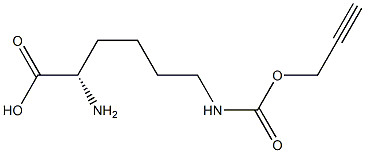N-ε-propargyloxycarbonyl-L-lysine
Modify Date: 2025-08-27 14:37:04

N-ε-propargyloxycarbonyl-L-lysine structure
|
Common Name | N-ε-propargyloxycarbonyl-L-lysine | ||
|---|---|---|---|---|
| CAS Number | 1215204-46-8 | Molecular Weight | 228.24504 | |
| Density | N/A | Boiling Point | N/A | |
| Molecular Formula | C10H16N2O4 | Melting Point | N/A | |
| MSDS | N/A | Flash Point | N/A | |
Use of N-ε-propargyloxycarbonyl-L-lysineN-ε-propargyloxycarbonyl-L-lysine (H-L-Lys(Poc)-OH) is a lysine-based unnatural amino acid (UAA). N-ε-propargyloxycarbonyl-L-lysine is widely used for bio-conjugation of fluorescent probes in diverse organisms from E. coli to mammalian cells even in animals[1][2]. |
| Name | (2S)-2-amino-6-{[(prop-2-yn-1-yloxy)carbonyl]amino}hexanoic acid |
|---|
| Description | N-ε-propargyloxycarbonyl-L-lysine (H-L-Lys(Poc)-OH) is a lysine-based unnatural amino acid (UAA). N-ε-propargyloxycarbonyl-L-lysine is widely used for bio-conjugation of fluorescent probes in diverse organisms from E. coli to mammalian cells even in animals[1][2]. |
|---|---|
| Related Catalog | |
| In Vitro | Labeling of N-ε-propargyloxycarbonyl-L-lysine (H-L-Lys(Poc)-OH)-carrying cellular proteins, such as Sec61β, Htt74Q and the histone H3 variant H3.3, with a sensitive Raman tag by click chemistry for molecular hyperspectral SRS imaging[1]. |
| References |
[2]. Enke HEIKE, et al. Modified microcystins and nodularins.WO2018206715A2 |
| Molecular Formula | C10H16N2O4 |
|---|---|
| Molecular Weight | 228.24504 |